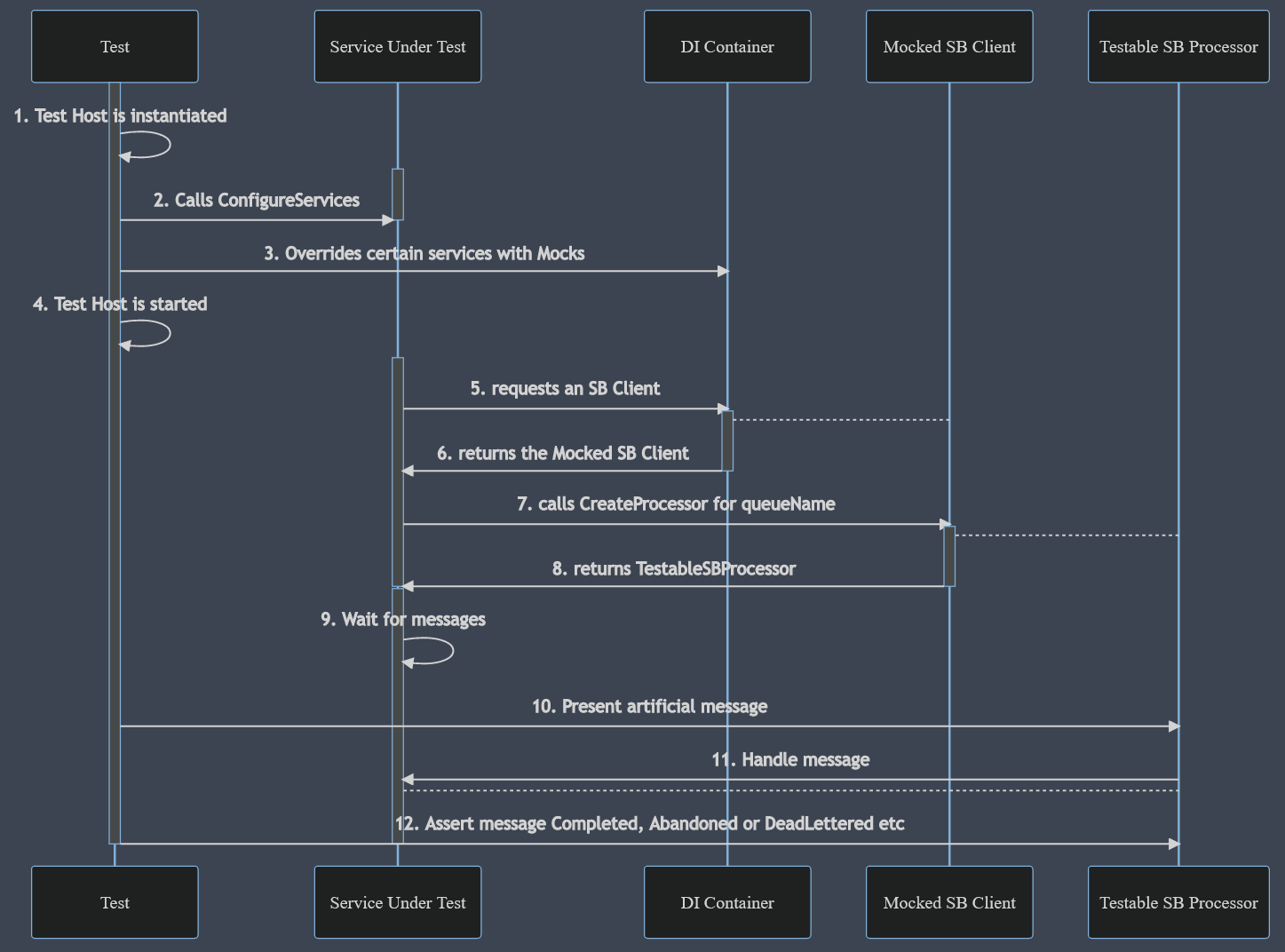TL/DR - At ClearBank we love testing and the new Azure.Messaging.ServiceBus package makes testing Service Bus handlers easy at last! Check out how we did it.
Background
In April 2020 Microsoft brought out a new client library for Azure Service Bus called Azure.Messaging.ServiceBus, this new library is based on the open Advanced Message Queuing Protocol (AMQP) standard. Microsoft outlines:
The class library documentation hints at this library being testable! This is great because one of the frustrations of using previous Service Bus client libraries was that absolutely everything was sealed or protected, meaning the only way to test client code was to wrap up and abstract away the service bus infrastructure. The situation might have been helped by a local emulator, but despite being a highly requested and up-voted feature request, an emulator was never officially implemented. So any improvements to the testability of Service Bus client code would be very welcome indeed!
The test support here is basically a few classes which are public and not sealed, a sprinkling of overridable methods and a factory class for creating models.
There are no official samples yet and very few (if any) blog posts covering how to test, but after a bit of trial and error we managed to get some tests working that we are quite pleased with, hence sharing here so that others might also benefit. This article covers testing the very basic handling of messages, although it should also be a useful starting point for testing more advanced features.
Component tests
At ClearBank we are favouring ‘component tests’ over reams of unit tests, I’m not sure who coined the name ‘component test’, but I see them as a kind of internal integration test. So we run some kind of test host, using real concrete objects, with the exception of anything which touches the network, these objects are mocked. We test as much of the service as possible i.e. including the Startup class and the Program class if possible. The tests include happy and sad paths, enough to give sufficiently high line and branch coverage of the tested services. These kind of tests take longer to setup than pure unit tests making Test Driven Development (TDD) a bit harder to start with, but they run locally, they run much faster and are less brittle than integration/end-to-end tests, giving the same confidence that the business logic is proven in a smaller number of tests than traditional unit tests. Of course, you still need a couple of integration tests but these need only prove that the integration is working, rather than all of the paths through the logic.
Testing message handlers
The main requirement when testing a service bus message handler is to be able to create a ServiceBusReceivedMessage. This class doesn’t have a public constructor, but there is ServiceBusModelFactory class with a ServiceBusReceivedMessage() method especially for the purpose! This needs to be at the heart of our test approach.
When we create the artificial ServiceBusReceivedMessage it needs to be packaged up in a ProcessMessageEventArgs however, if we want to spy on what happens to the message, we can inherit from this class and override CompleteMessageAsync, DeadLetterMessageAsync and AbandonMessageAsync methods and set flags accordingly. We called this class TestableProcessMessageEventArgs.
Here is our TestableProcessMessageEventArgs class
public class TestableProcessMessageEventArgs : ProcessMessageEventArgs
{
public bool WasCompleted{ get; private set; }
public bool WasDeadLettered{ get; private set; }
public DateTime Created{ get; }
public TestableProcessMessageEventArgs(ServiceBusReceivedMessage message) : base(message, null, CancellationToken.None)
{
Created = DateTime.Now;
}
public override Task CompleteMessageAsync(ServiceBusReceivedMessage message,
CancellationToken cancellationToken = new CancellationToken())
{
WasCompleted = true;
return Task.CompletedTask;
}
public override Task DeadLetterMessageAsync(ServiceBusReceivedMessage message, string deadLetterReason,
string deadLetterErrorDescription = null, CancellationToken cancellationToken = new())
{
WasDeadLettered = true;
return Task.CompletedTask;
}
public override Task AbandonMessageAsync(ServiceBusReceivedMessage message, IDictionary<string, object> propertiesToModify = null,
CancellationToken cancellationToken = new CancellationToken())
{
return Task.CompletedTask;
}
}
The next thing we need to mock is the ServiceBusProcessor class, this is returned by the ServiceBusClient and communicates with the service bus, passing messages to the handler for a specific queue or topic. We could try to use Moq but its easier to inherit from ServiceBusProcessor and override its StartProcessingAsync() method, this stops it from realising that it isn’t connected to a real service bus. We called this class TestableServiceBusProcessor.
We can then call base.OnProcessMessageAsync(args) on the TestableServiceBusProcessor passing in a an artificial message created using the
ServiceBusModelFactory.ServiceBusReceivedMessage() mentioned above. This will present the artificial message to the handler, as if it were connected to a real service bus receiving a real message.
We can add a couple of helpful features to the TestableServiceBusProcessor such as a collection of TestableProcessMessageEventArgs called MessageDeliveryAttempts to assert against and a generic method for sending messages, we can also simulate retries in order to test sad paths and/or exponential back off policies etc.
Here is our TestableServiceBusProcessor class
public class TestableServiceBusProcessor : ServiceBusProcessor
{
public List<TestableProcessMessageEventArgs> MessageDeliveryAttempts = new();
public async Task SendMessageWithRetries<T>(T payload, int maxDeliveryCount = 5)
{
for (var attempt = 1; attempt <= maxDeliveryCount; attempt++)
{
// Don't send retry if the message was sent already and completed
if (MessageDeliveryAttempts.Any() && MessageDeliveryAttempts.Last().WasCompleted)
return;
await SendMessage(payload, attempt);
// Simulate the message being deadlettered if max delivery count is hit
if (attempt == maxDeliveryCount)
MessageDeliveryAttempts.Last().WasDeadLettered = true;
}
}
public async Task SendMessage<T>(T payload, int attempt = 1)
{
var args = CreateMessageArgs(payload, attempt);
MessageDeliveryAttempts.Add((TestableProcessMessageEventArgs)args);
await base.OnProcessMessageAsync(args);
}
public ProcessMessageEventArgs CreateMessageArgs<T>(T payload, int deliveryCount = 1)
{
var payloadJson = JsonSerializer.Serialize(payload);
var message = ServiceBusModelFactory.ServiceBusReceivedMessage(
body: BinaryData.FromString(payloadJson),
deliveryCount: deliveryCount);
var args = new TestableProcessMessageEventArgs(message);
return args;
}
public override async Task StartProcessingAsync(CancellationToken cancellationToken = default)
{
}
}
How to use them
So, to use these classes in a component test, we can use the excellent TestHost from the Microsoft.AspNetCore.TestHost package, this enables us to run a service in memory, calling the ConfigureServices method as normal, but then overriding some of the configurations i.e. the ones that touch the network that we need to mock. Consider the following code:
public class TestHost : IDisposable
{
private readonly IHost _server;
public Mock<ServiceBusSender> MockTestQueue2Sender { get; } = new();
public TestableServiceBusProcessor TestableQueue1MessageProcessor { get; } = new();
public Mock<IWidget> MockWidgetService { get; } = new();
public IServiceProvider Services => _server.Services;
public int NumberOfSimulatedServiceBusMessageRetries = 5;
public int InitialRetryDelayForServiceBusMessageRetriesInMs = 100;
public TestHost()
{
var builder = new HostBuilder()
.ConfigureWebHost(webHost =>
{
webHost.UseTestServer()
.ConfigureServices((context, services) => Program.ConfigureHost(services, context.Configuration))
.ConfigureTestServices((services) =>
{
var client = new Mock<ServiceBusClient>();
client.Setup(t => t.CreateSender(It.Is < string > (s => s == "testQueue2")))
.Returns(MockTestQueue2Sender.Object);
client.Setup(t => t.CreateProcessor(It.Is<string>(s => s == $"testQueue1")))
.Returns(TestableQueue1MessageProcessor);
services.AddSingleton(client.Object);
// register other test services here...
services.AddSingleton(MockWidgetService.Object);
}).Configure(app => { });
});
_server = builder.Build();
_server.StartAsync();
}
public void Dispose()
{
_server?.StopAsync().GetAwaiter().GetResult();
_server?.Dispose();
}
}
So we’re using Moq to create a Mock ServiceBusClient, this will be registered into the DI container and when it’s CreateProcessor() method is called with the correct queue name, an instance of our TestableServiceBusProcessor will be returned. We are also setting up a Mock ServiceBusSender which we can use later to Assert whether messages were sent to a different queue.
Finally we have a Mock IWidget service, which our message handler calls and we can use to throw exceptions or simulate processing delays etc.

The actual tests
The following code shows the actual tests, we decided to split the setup, execution and assertion into a set of helpers named Given, When and Then, this allows for a nice fluent interface for the tests and makes them nice and readable.
[Fact]
public void a_message_sent_to_the_queue_is_handled_and_completed()
{
using var host = new TestHost();
Given.OnThe(host)
.ATestPayloadIsGenerated(out var testPayload);
When.OnThe(host)
.AMessageIsSentToTestQueue1(testPayload);
Then.OnThe(host)
.TheWidgetServiceWasCalled(times: 1)
.And().AMessageWasSentToTestQueue2()
.And().TheMessageWasCompleted();
}
[Fact]
public void a_message_sent_to_the_queue_is_handled_and_when_permanentException_is_thrown_is_dead_lettered()
{
using var host = new TestHost();
Given.OnThe(host)
.ATestPayloadIsGenerated(out var testPayload)
.And().TheWidgetWillThrowAPermanentException();
When.OnThe(host)
.AMessageIsSentToTestQueue1(testPayload);
Then.OnThe(host)
.AMessageWasSentToTestQueue2(times: 0)
.And().TheMessageWasDeadLettered();
}
[Fact]
public void a_message_sent_to_the_queue_is_handled_and_when_transientException_is_thrown_is_retried_and_is_eventually_completed()
{
using var host = new TestHost();
Given.OnThe(host)
.ATestPayloadIsGenerated(out var testPayload)
.And().TheWidgetWillThrowANumberOfTransientExceptions(times:3);
When.OnThe(host)
.AMessageIsSentToTestQueue1(testPayload, simulateRetries: true);
Then.OnThe(host)
.TheMessageWasRetried(times:4)
.And().TheWidgetServiceWasCalled(times:4)
.And().TheRetriedMessagesHadIncreasingDelays()
.And().AMessageWasSentToTestQueue2(times:1)
.And().TheMessageWasCompleted();
}
Given, When and Then test helpers
Here is the code for the When class which simulates the message appearing on the queue
public class When
{
private readonly TestHost _host;
public When(TestHost host)
{
_host = host;
}
public static When OnThe(TestHost host) => new(host);
public When And() => this;
public When AMessageIsSentToTestQueue1(string testPayload, bool simulateRetries = false)
{
var payload = new TestQueueMessage(testPayload);
if (simulateRetries)
_host.TestableQueue1MessageProcessor.SendMessageWithRetries(payload, _host.NumberOfSimulatedServiceBusMessageRetries).GetAwaiter().GetResult();
else
_host.TestableQueue1MessageProcessor.SendMessage(payload).GetAwaiter().GetResult();
return this;
}
}
And here is the code for the Then class which demonstrates how to use the TestableServiceBusProcessor and its collection of MessageDeliveryAttempts, each of which contains a TestableProcessMessageEventArgs that be can used to make assertions. We are using the FluentAssertions package.
public class Then
{
private readonly TestHost _host;
public Then(TestHost host)
{
_host = host;
}
public static Then OnThe(TestHost host) => new(host);
public Then And() => this;
public Then TheMessageWasCompleted()
{
_host.TestableQueue1MessageProcessor.MessageDeliveryAttempts.Last().WasCompleted.Should().BeTrue();
return this;
}
public Then TheMessageWasDeadLettered()
{
_host.TestableQueue1MessageProcessor.MessageDeliveryAttempts.Last().WasDeadLettered.Should().BeTrue();
return this;
}
public Then TheMessageWasRetried(int times)
{
_host.TestableQueue1MessageProcessor.MessageDeliveryAttempts.Count.Should().Be(times);
return this;
}
public Then TheWidgetServiceWasCalled(int times)
{
_host.MockWidgetService.Verify(x => x.DoSomething(It.IsAny<string>()), Times.Exactly(times));
return this;
}
public Then AMessageWasSentToTestQueue2(int times = 1)
{
_host.MockTestQueue2Sender.Verify(x => x.SendMessageAsync(It.IsAny<ServiceBusMessage>(), It.IsAny<CancellationToken>()), Times.Exactly(times));
return this;
}
public Then TheRetriedMessagesHadIncreasingDelays()
{
var delays = new List<TimeSpan>();
for (var i = 0; i < _host.TestableQueue1MessageProcessor.MessageDeliveryAttempts.Count - 1; i++)
{
delays.Add(_host.TestableQueue1MessageProcessor.MessageDeliveryAttempts[i + 1].Created -
_host.TestableQueue1MessageProcessor.MessageDeliveryAttempts[i].Created);
}
for (var i = 0; i < delays.Count - 1; i++)
{
Assert.True(delays[i + 1] > delays[i], $"the interval of retry{i+1}({delays[i+1].TotalMilliseconds}ms) was not larger than the previous retry({delays[i].TotalMilliseconds}ms)");
}
return this;
}
}
And that is how we are testing message handling code which uses the Azure.Messaging.Servicebus client library. Thankyou for reading and hope you find it useful.
All of the code from this post can be found here
The title image is from here
This blog was first published on the ClearBank tech blog
